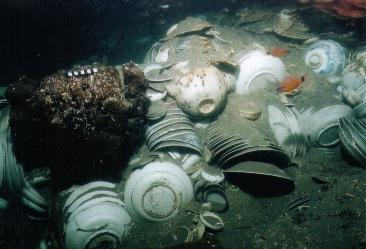Binh Thuan (1608)

The Binh Thuan shipwreck was first discovered in 2001 by fishermen while trying to unravel a trawl net caught in the wreckage. It lies 41 meters (135 feet) below the surface about 65 kilometers (40 miles) off the coast of Binh Thuan province. The hull was that of a Chinese junk, 24 m long, 7 m wide, and divided into 25 narrow compartments by transverse bulkheads. Archival evidence points to the junk of the unfortunate merchant, I Sin Ho, who was transporting a cargo of silk and Chinese goods from China to Johore for the Dutch when his ship sank off the south of Vietnam in 1608.
The non-perishable cargo comprised cast-iron pans and Zhangzhou (Swatow) porcelain: blue-and-white, overglaze enamels, and a combination of the two. This is the first dedicated cargo of Zhangzhou porcelain to ever be found. There were also finer blue-and-white ceramics in a variety of shapes from other kilns. Non-ceramic artefacts were typical of a Chinese junk, and included locks, a set of scales, chopsticks, and copper alloy bowls and dishes.





